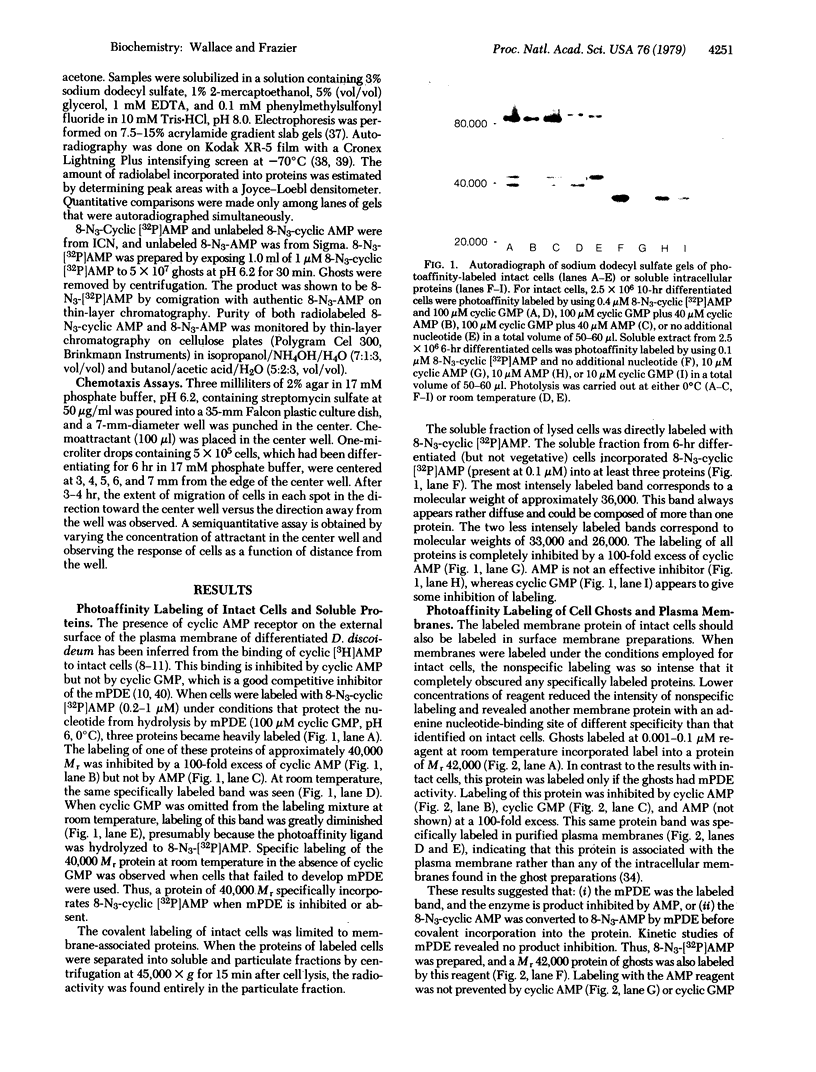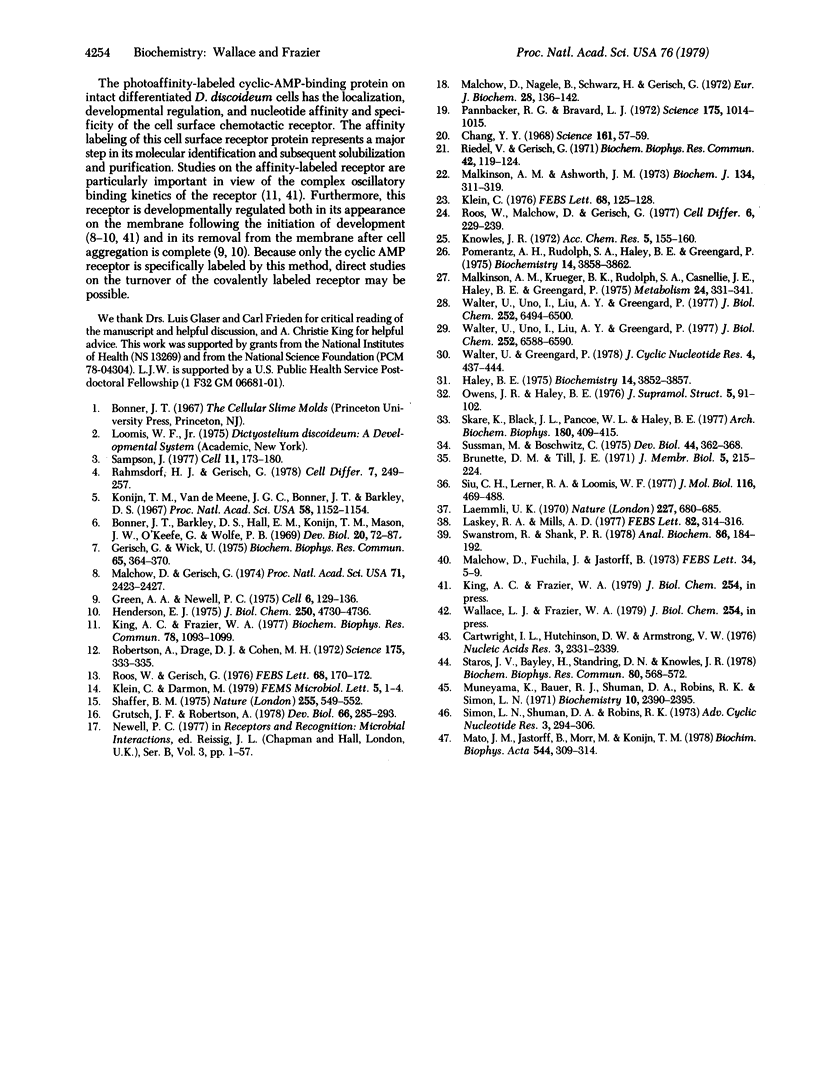Abstract
Cyclic-AMP-binding proteins play important roles during the differentiation of the cellular slime mold Dictyostelium discoideum. The photoaffinity reagent 8-N3-cyclic [32P]AMP has been used to label developmentally regulated cyclic-AMP-binding proteins of intact cells, membranes, and cytoplasm. 8-N3-Cyclic AMP is a chemoattractant for differentiated D. discoideum cells and is a substrate for the membrane phosphodiesterase (mPDE). When mPDE is inhibited, the only specifically labeled protein on intact cells has a molecular weight of 40,000 on sodium dodecyl sulfate gels. The developmental time course of appearance of this protein and its high specificity for cyclic AMP identify it as the cell surface chemotactic receptor for cyclic AMP. The concentration dependence of labeling of this protein is consistent with the measured chemotactic potency of 8-N3-cyclic AMP, which is about 1/100th that of cyclic AMP. Three developmentally regulated proteins (Mr 26,000, 33,000, and 36,000) of the soluble fraction (cytoplasm) are labeled by the photoaffinity reagent and are specific for cyclic AMP. By analogy with other systems, these may be regulatory subunits of protein kinases. The mPDE of ghosts or plasma membrane fractions converts the reagent to 8-N3-[32P]AMP, which specifically photoaffinity labels a protein of Mr 42,000 associated with the cytoplasmic face of the plasma membrane.
Full text
PDF




Images in this article
Selected References
These references are in PubMed. This may not be the complete list of references from this article.
- Bonner J. T., Barkley D. S., Hall E. M., Konijn T. M., Mason J. W., O'Keefe G., 3rd, Wolfe P. B. Acrasin, Acrasinase, and the sensitivity to acrasin in Dictyostelium discoideum. Dev Biol. 1969 Jul;20(1):72–87. doi: 10.1016/0012-1606(69)90005-0. [DOI] [PubMed] [Google Scholar]
- Cartwright I. L., Hutchinson D. W., Armstrong V. W. The reaction between thiols and 8-azidoadenosine derivatives. Nucleic Acids Res. 1976 Sep;3(9):2331–2339. doi: 10.1093/nar/3.9.2331. [DOI] [PMC free article] [PubMed] [Google Scholar]
- Chang Y. Y. Cyclic 3',5'-adenosine monophosphate phosphodiesterase produced by the slime mold Dictyostelium discoideum. Science. 1968 Jul 5;161(3836):57–59. doi: 10.1126/science.161.3836.57. [DOI] [PubMed] [Google Scholar]
- Gerisch G., Wick U. Intracellular oscillations and release of cyclic AMP from Dictyostelium cells. Biochem Biophys Res Commun. 1975 Jul 8;65(1):364–370. doi: 10.1016/s0006-291x(75)80102-1. [DOI] [PubMed] [Google Scholar]
- Green A. A., Newell P. C. Evidence for the existence of two types of cAMP binding sites in aggregating cells of Dictyostelium discoideum. Cell. 1975 Oct;6(2):129–136. doi: 10.1016/0092-8674(75)90003-3. [DOI] [PubMed] [Google Scholar]
- Grutsch J. F., Robertson A. The cAMP signal from Dictyostelium discoideum amoebae. Dev Biol. 1978 Oct;66(2):285–293. doi: 10.1016/0012-1606(78)90238-5. [DOI] [PubMed] [Google Scholar]
- Haley B. E. Photoaffinity labeling of adenosine 3',5'-cyclic monophosphate binding sites of human red cell membranes. Biochemistry. 1975 Aug 26;14(17):3852–3857. doi: 10.1021/bi00688a018. [DOI] [PubMed] [Google Scholar]
- Henderson E. J. The cyclic adenosine 3':5'-monophosphate receptor of Dictyostelium discoideum. Binding characteristics of aggregation-competent cells and variation of binding levels during the life cycle. J Biol Chem. 1975 Jun 25;250(12):4730–4736. [PubMed] [Google Scholar]
- King A. C., Frazier W. A. Reciprocal periodicity in cyclic AMP binding and phosphorylation of differentiating Dictyostelium discoideum cells. Biochem Biophys Res Commun. 1977 Oct 10;78(3):1093–1099. doi: 10.1016/0006-291x(77)90533-2. [DOI] [PubMed] [Google Scholar]
- Klein C. Adenylate cyclase activity in Dictyostelium discoideum amoebae and its changes during differentiation. FEBS Lett. 1976 Sep 15;68(1):125–128. doi: 10.1016/0014-5793(76)80419-x. [DOI] [PubMed] [Google Scholar]
- Konijn T. M., Van De Meene J. G., Bonner J. T., Barkley D. S. The acrasin activity of adenosine-3',5'-cyclic phosphate. Proc Natl Acad Sci U S A. 1967 Sep;58(3):1152–1154. doi: 10.1073/pnas.58.3.1152. [DOI] [PMC free article] [PubMed] [Google Scholar]
- Laemmli U. K. Cleavage of structural proteins during the assembly of the head of bacteriophage T4. Nature. 1970 Aug 15;227(5259):680–685. doi: 10.1038/227680a0. [DOI] [PubMed] [Google Scholar]
- Laskey R. A., Mills A. D. Enhanced autoradiographic detection of 32P and 125I using intensifying screens and hypersensitized film. FEBS Lett. 1977 Oct 15;82(2):314–316. doi: 10.1016/0014-5793(77)80609-1. [DOI] [PubMed] [Google Scholar]
- Malchow D., Fuchila J., Jastorff B. Correlation of substrate specificity of cAMP-phosphodiesterase in Dictyostelium discoideum with chemotactic activity of cAMP-analogues. FEBS Lett. 1973 Aug 1;34(1):5–9. doi: 10.1016/0014-5793(73)80690-8. [DOI] [PubMed] [Google Scholar]
- Malchow D., Gerisch G. Short-term binding and hydrolysis of cyclic 3':5'-adenosine monophosphate by aggregating Dictyostelium cells. Proc Natl Acad Sci U S A. 1974 Jun;71(6):2423–2427. doi: 10.1073/pnas.71.6.2423. [DOI] [PMC free article] [PubMed] [Google Scholar]
- Malchow D., Nägele B., Schwarz H., Gerisch G. Membrane-bound cyclic AMP phosphodiesterase in chemotactically responding cells of Dictyostelium discoideum. Eur J Biochem. 1972 Jun 23;28(1):136–142. doi: 10.1111/j.1432-1033.1972.tb01894.x. [DOI] [PubMed] [Google Scholar]
- Malkinson A. M., Ashworth J. M. Adenosine 3':5'-cyclic monophosphate concentrations and phosphodiesterase activities during axenic growth and differentiation of cells of the cellular slime mould Dictyostelium discoideum. Biochem J. 1973 May;134(1):311–319. doi: 10.1042/bj1340311. [DOI] [PMC free article] [PubMed] [Google Scholar]
- Malkinson A. M., Krueger B. K., Rudolph S. A., Casnellie J. E., Haley B. E., Greengard P. Widespread occurrence of a specific protein in vertebrate tissues and regulation by cyclic AMP of its endogenous phosphorylation and dephosphorylation. Metabolism. 1975 Mar;24(3):331–341. doi: 10.1016/0026-0495(75)90114-6. [DOI] [PubMed] [Google Scholar]
- Mato J. M., Jastorff B., Morr M., Konijn T. M. A model for cyclic AMP-chemoreceptor interaction in Dictyostelium discoideum. Biochim Biophys Acta. 1978 Dec 1;544(2):309–314. doi: 10.1016/0304-4165(78)90099-5. [DOI] [PubMed] [Google Scholar]
- Muneyama K., Bauer R. J., Shuman D. A., Robins R. K., Simon L. N. Chemical synthesis and biological activity of 8-substituted adenosine 3',5'-cyclic monophosphate derivatives. Biochemistry. 1971 Jun 8;10(12):2390–2395. doi: 10.1021/bi00788a033. [DOI] [PubMed] [Google Scholar]
- Owens J. R., Haley B. E. A study of adenosine 3'-5' cyclic monophosphate binding sites of human erythrocyte membranes using 8-azidoadenosine 3'-5' cyclic monophosphate, a photoaffinity probe. J Supramol Struct. 1976;5(1):91–102. doi: 10.1002/jss.400050110. [DOI] [PubMed] [Google Scholar]
- Pannbacker R. G., Bravard L. J. Phosphodiesterase in Dictyostelium discoideum and the chemotactic response to cyclic adenosine monophosphate. Science. 1972 Mar 3;175(4025):1014–1015. doi: 10.1126/science.175.4025.1014. [DOI] [PubMed] [Google Scholar]
- Pomerantz A. H., Rudolph S. A., Haley B. E., Greengard P. Photoaffinity labeling of a protein kinase from bovine brain with 8-azidoadenosine 3',5'-monophosphate. Biochemistry. 1975 Aug 26;14(17):3858–3862. doi: 10.1021/bi00688a019. [DOI] [PubMed] [Google Scholar]
- Rahmsdorf H. J., Gerisch G. Specific binding proteins for cyclic AMP and cyclic GMP in Dictyostelium discoideum. Cell Differ. 1978 Oct;7(5):249–257. doi: 10.1016/0045-6039(78)90026-x. [DOI] [PubMed] [Google Scholar]
- Riedel V., Gerisch G. Regulation of extracellular cyclic-AMP-phosphodiesterase activity during development of Dictyostelium discoideum. Biochem Biophys Res Commun. 1971 Jan 8;42(1):119–124. doi: 10.1016/0006-291x(71)90370-6. [DOI] [PubMed] [Google Scholar]
- Robertson A., Drage D. J., Cohen M. H. Control of Aggregation in Dictyostelium discoideum by an External Periodic Pulse of Cyclic Adenosine Monophosphate. Science. 1972 Jan 21;175(4019):333–335. doi: 10.1126/science.175.4019.333. [DOI] [PubMed] [Google Scholar]
- Roos W., Gerisch G. Receptor-mediated adenylate cyclase activation in Dictyostelium discoideum. FEBS Lett. 1976 Oct 1;68(2):170–172. doi: 10.1016/0014-5793(76)80429-2. [DOI] [PubMed] [Google Scholar]
- Roos W., Malchow D., Gerisch G. Adenylyl cyclase and the control of cell differentiation in Dictyostelium dicoideum. Cell Differ. 1977 Oct;6(3-4):229–239. doi: 10.1016/0045-6039(77)90018-5. [DOI] [PubMed] [Google Scholar]
- Sampson J. Developmentally regulated cyclic AMP-dependent protein kinases in Dictyostelium discoideum. Cell. 1977 May;11(1):173–180. doi: 10.1016/0092-8674(77)90328-2. [DOI] [PubMed] [Google Scholar]
- Shaffer B. M. Secretion of cyclic AMP induced by cyclic AMP in the cellular slime mould Dictyostelium discoideum. Nature. 1975 Jun 12;255(5509):549–552. doi: 10.1038/255549a0. [DOI] [PubMed] [Google Scholar]
- Siu C. H., Lerner R. A., Loomis W. F., Jr Rapid accumulation and disappearance of plasma membrane proteins during development of wild-type and mutant strains of Dictyostelium discoideum. J Mol Biol. 1977 Nov 5;116(3):469–488. doi: 10.1016/0022-2836(77)90080-8. [DOI] [PubMed] [Google Scholar]
- Skare K., Black J. L., Pancoe W. L., Haley B. E. Determination of the cellular location of cyclic nucleotide binding sites using 8-azidoadenosine-3', 5'-monophosphate, a photoaffinity probe. Arch Biochem Biophys. 1977 Apr 30;180(2):409–415. doi: 10.1016/0003-9861(77)90055-8. [DOI] [PubMed] [Google Scholar]
- Staros J. V., Bayley H., Standring D. N., Knowles J. R. Reduction of aryl azides by thiols: implications for the use of photoaffinity reagents. Biochem Biophys Res Commun. 1978 Feb 14;80(3):568–572. doi: 10.1016/0006-291x(78)91606-6. [DOI] [PubMed] [Google Scholar]
- Sussman M., Boschwitz C. Adhesive properties of cell ghosts derived from Dictyostelium discoideum. Dev Biol. 1975 Jun;44(2):362–368. doi: 10.1016/0012-1606(75)90406-6. [DOI] [PubMed] [Google Scholar]
- Swanstrom R., Shank P. R. X-Ray Intensifying Screens Greatly Enhance the Detection by Autoradiography of the Radioactive Isotopes 32P and 125I. Anal Biochem. 1978 May;86(1):184–192. doi: 10.1016/0003-2697(78)90333-0. [DOI] [PubMed] [Google Scholar]
- Walter U., Greengard P. Quantitative labeling of the regulatory subunit of type II cAMP-dependent protein kinase from bovine heart by a photoaffinity analog. J Cyclic Nucleotide Res. 1978 Dec;4(6):437–444. [PubMed] [Google Scholar]
- Walter U., Uno I., Liu A. Y., Greengard P. Identification, characterization, and quantitative measurement of cyclic AMP receptor proteins in cytosol of various tissues using a photoaffinity ligand. J Biol Chem. 1977 Sep 25;252(18):6494–6500. [PubMed] [Google Scholar]
- Walter U., Uno I., Liu A. Y., Greengard P. Study of autophosphorylation of isoenzymes of cyclic AMP-dependent protein kinases. J Biol Chem. 1977 Oct 10;252(19):6588–6590. [PubMed] [Google Scholar]







